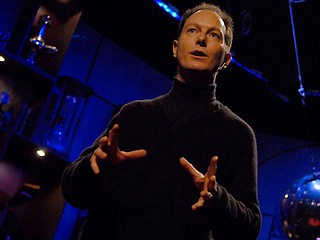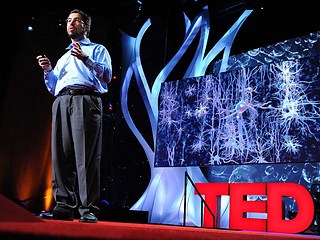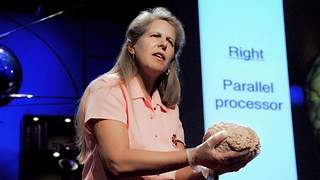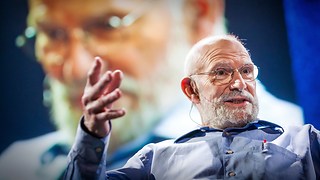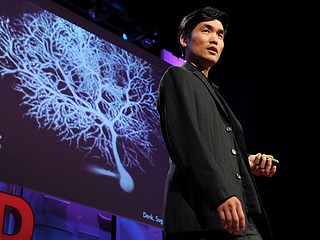Summary analysis
After watching the collection of talks on Mapping and Manipulating the Brain, read a thoughtful recap of the major points in this TED Study, and learn where experts believe things are headed.
Towards a holistic, scientific understanding of brain function and human consciousness
A recurring theme throughout the TEDTalks in Mapping and Manipulating the Brain — and a major principle guiding our understanding of brain function — is that signals representing different elements of the world around us are processed in different, specific parts of the brain. This raises a really big unanswered question: how is a global conscious awareness of the world synthesized?
Does the localization of different cognitive functions to particular geographical regions of the brain break down as we get to higher and higher levels and an integrated model of reality is generated? What is the nature of consciousness and can we ever hope to understand it? If we could explain the behavior of another person based on knowledge of the way the machine in their head works, what place will consciousness have in our understanding of that? How do we observe consciousness in others? Or do we just assume it?
We are still worlds away from answering these big questions. To do so, we'll need the circuit diagram of the brain's connections from Sebastian Seung and others working in connectomics, but much more than that, we'll need to understand how the circuits function to integrate information from multiple sources and we'll need a better understanding of synapses work to provide that integration.
Future research should involve not only reductionist but also holistic approaches to understand the nature of perception, the abstractions from reality made by the brain and its creation of apparent reality, like the phenomena described by Oliver Sacks and VS Ramachandran. These are daunting and exciting tasks.
A major challenge: understanding how the brain develops normally and how this process can go wrong
The human brain self-constructs within nine months to a high level of performance: a baby is born ready for further development and learning. How is this achieved? If we could understand it, could we harness this knowledge? For example, could we generate computers more efficiently and with greater potential?
Brain development is controlled by a combination of genetic and epigenetic factors and is influenced by the stimulation the brain receives from the environment of the organism. We now know the sequence of the genome of many animals, but this is not enough without understanding how the genome works and is controlled. We can expect significant advances in this field in the years ahead.
What about when brain development doesn't proceed normally? What causes brain connectivity to go wrong, resulting in neurological and psychiatric disorders? Here we're only scratching the surface with our current knowledge. While work on model animals can help us understand evolutionarily conserved processes like brain development and function, it has limitations in helping us understand diseases that may be peculiar to humans, or at least to species with the highest cognitive abilities. One example is schizophrenia, a complex condition whose diagnosis relies on knowledge of the individual sufferer that no animal could volunteer (see the 2012 TEDTalk "Elyn Saks: A tale of mental illness -- from the inside").
A challenge, therefore, will be to extrapolate work from model species to humans. This will require a better understanding of the developmental mechanisms have evolved to give us such advanced brains. Another challenge is to better education about mental illness, which still carries a terrible social stigma; we need to think not only about gaining more knowledge but disseminating what we've got more widely, using it to change attitudes (see the 2012 TEDTalk "Ruby Wax: What's so funny about mental illness?").
New ways of treating brain disorders
Many neurological and psychiatric disorders are still incurable. Can we find new treatments? Many TEDTalks in Mapping and Manipulating the Brain focused on this, and the speakers showed how they're using fiber optics, real-time fMRI, magnets and mirrors to control or cure conditions like PTSD, chronic pain, epilepsy, phantom limb pain and more. All of these methods offer potential alternatives and advantages over current surgical or pharmaceutical approaches with their many side effects. The major challenge will be to turn this potential into practical, widely-available treatment options.
Whether they're gaining new knowledge about how the remarkable organ inside our heads does what it does, or learning more about diseases of the brain and their potential cures, or catalyzing new technologies in the physical and computing sciences, neuroscience researchers and teachers are incredibly active. Neuroscientists draw increasingly on the expertise of scientists in other disciplines, including physics, mathematics and computing, to try to unravel the mysteries of the brain, and increasingly use the skills of communicators and artists to convey fascinating and important insights to the public. Understanding more about Mapping and Manipulating the Brain is an enterprise that can and should include us all.
Relevant talks
